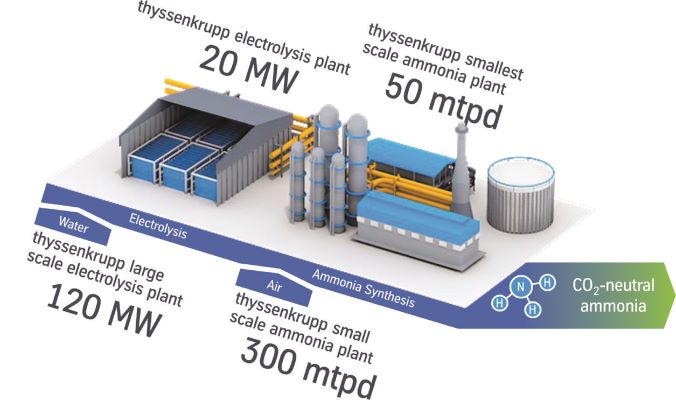Companies are prioritizing climate-friendly production solutions as they face ever- increasing pressure to reduce greenhouse gas emissions and decarbonize operations. With this in mind, thyssenkrupp Uhde has developed an ammonia production solution based on renewable feedstocks that is 100% CO2-free. Production of ammonia that is CO2-free is designated as green ammonia. Besides climate considerations, other drivers of the move to distributed production of green ammonia from small-scale plants have been the desire for localised self-sufficiency, avoidance of high transportation costs and import or carbon taxes.
Nithesh Mohun, Senior Sales Engineer at thyssenkrupp Uhde, explains: “Whereas in conventional ammonia plants, ammonia is produced by steam reforming natural gas, thyssenkrupp Uhde’s green ammonia production is underpinned by nucera’s alkaline water electrolysis (AWE) technology. nucera is a sister company to thyssenkrupp Uhde.
According to Mohun, the feedstocks for the green ammonia production are hydrogen, water and renewable power. Renewable power is produced by either solar PV, wind, hydropower or a combination thereof. Mohun explains green ammonia production, “Within the AWE (Alkaline Water Electrolysis) plant, water is converted into green hydrogen by the application of direct electrical current. Nitrogen is produced in an air separation unit (ASU).”
For green ammonia production, thyssenkrupp Uhde has developed solutions with capacities ranging from 50 tpd up to 3000 tpd. “Our smaller scale plants in capacity classes 50 tpd, 300 tpd, 600 tpd and 1200 tpd are offered on a fully modularized basis,” adds Mohun. The plants are fabricated, pre-assembled and pre-commissioned as skids for easy transportation. Larger plant capacities are governed by stick-built assembly. The hydrogen and ammonia modular solutions are matched. For example, the 50 tpd module is paired with a 20 MW AWE plant and the 300 tpd module is paired with a 120 MW AWE plant.
The benefits of modularization include reduced implementation timeframes and project investment costs, improved quality control, and greater risk mitigation through significant reduction of on-site construction effort and time.
Small-scale ammonia plants have the advantage of distributed production location and reduction of logistics risks and costs. The small-scale plant can be designed to service the immediate market, thereby limiting capital outlay and transportation of large consignments of the product as well as logistics risks in off-loading and storage.
Mohun points out that small-scale green ammonia plants can compete with conventional plants under the right frame conditions. “The key drivers for green ammonia competitiveness are reduced capital expenditure, cost effective renewable power supply and stringent CO2 taxes and penalties. In most parts of the world renewable power is now more affordable than power produced from fossil fuels.”
“Governments and environmental organizations are strongly driving enforcement of CO2 taxes and penalties,” continues Mohun. “Considering the above, green ammonia is expected to reach price parity with conventional ammonia production in the foreseeable future, e.g. by leveraging CO2 incentives and eliminating the need to import ammonia over long distances.”
thyssenkrupp Uhde also offers conventional ammonia production plants up to 5 000 tpd. When the project focus is on conventional ammonia production, thyssenkrupp Uhde offers the modular A01 and A04 series Gas Heater Reformer (GHR) solution with capacities ranging from 50 – 350 tpd. The GHR solution was developed in collaboration with Johnson Matthey. The system is based on GHR technology with a pressure swing adsorption (PSA) system at the front end and thyssenkrupp Uhde low-pressure synthesis loop at the back end.
The design is less complicated than a conventional primary/secondary reformer and is especially suited for small capacities with low ammonia needs and high transportation challenges. The GHR is a cost-effective solution as it eliminates the need for an externally-fired primary reformer, the elaborate waste heat-recovery section and the consequent excess steam production.
Moreover, as the reforming operates with air, there is no need for an air separation unit. The modular nature of the GHR offers, amongst others, reduced implementation timeframes, improved quality control and reduced project investment.
thyssenkrupp Uhde has a proud track record in ammonia plant delivery. Since 1928, over 130 ammonia plants have been built worldwide. For more information on thyssenkrupp Uhde’s world leading green hydrogen, ammonia and fertiliser solutions .








